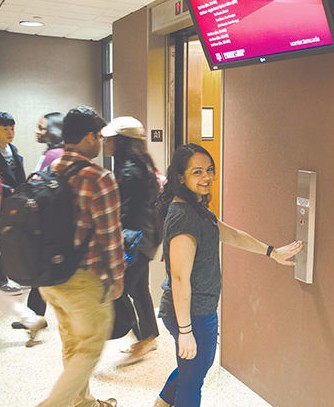Accessibility for all Aggies (TX UCEDD)
April 24, 2017

|
For the majority of college students getting to their classes is a feasible everyday routine. However, some members of the Aggie family who are physically disabled face a larger challenge.
Jordan Cox, environmental design and Spanish senior who has a disability, said after her disability progressed freshman year she began receiving services but did not necessarily feel comfortable using her wheelchair on campus.
"One of the biggest problems that I notice and that deters me from using a wheelchair on campus is the fact that we can't necessarily easily find the [handicap] entrances, so we spend physical exertion and time trying to find the handicap entrance and getting to our classroom as we could actually walking or taking the time to do that. I think that's the biggest problem - the wayfinding," Cox said.
Cox said while there is definitely progress being made with handicap accessible buildings, handicap accessible does not always equal handicap friendly.
"I think there's good things and bad things about A&M accessibility as far as wheelchairs are concerned. For the most part most of the buildings are going to be wheelchair accessible, at least the ones that are used for public access," Cox said. "But some of the older buildings on campus that weren't built when ADA code was as stringent aren't going to be handicap accessible."
Jaime Mitash, a human resources management graduate student who is registered with Disability Services, was on the Disability Services Student Advisory Board as an undergrad and started Chronicles, the awareness and support group for students with chronic illnesses and disability at A&M. She said because ADA was established in 1990 there are a lot of buildings on campus that are not wheelchair accessible.
"I think there are a lot of buildings that do have a lot of history and are so old that they were created before ADA accommodations were a thing for most people to consider," Mitash said. "I would hope that we would find ways that allow us to preserve the tradition of Texas A&M university while moving forward and being more friendly toward accommodations and diverse populations."
Cox said while retroactively adding handicap accessibility to buildings is a difficult task, there are things the university can do to make campus more handicap friendly.
"In the instance of the Francis Hall renovation they implemented a handicap ramp that was easily visible in the front of the building that didn't deter from the natural aesthetic of the building. They made it very clear and made it easy to understand what that was for," Cox said. "Making sure that they are thoughtfully considered during the design of the building when you're implementing something new is really important."
While Cox and Mitash said a lack in handicap accessibility can be seen, other physically disabled members of the Aggie family disagree. Matthew Swick, office assistant for Disability Services who has worked for A&M for 10 years and is physically disabled, said he believes the campus is wheelchair accessible, and said Disability Services offers a variety of services for physically disabled students.
"I believe that A&M is wheelchair friendly ... I've been to most buildings and they're ADA compliant," Swick said. "We have students who are in wheelchairs who need quiet environments like other students that come to take our exams here with us and if they need help getting around campus we can refer them to transportation services."
Mitash said students who are disabled should know that resources and help are readily available at Texas A&M.
"Don't be afraid to ask for resources or help from anybody who would be able to give it to you," Mitash said. "If you voice your concerns people are going to want you to be comfortable on campus and help you do what you need to do to be a successful student."







